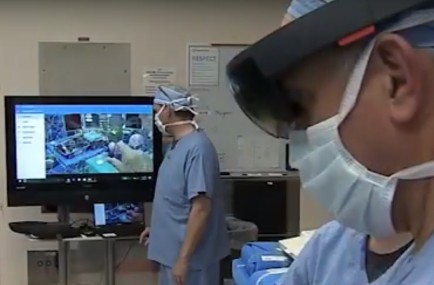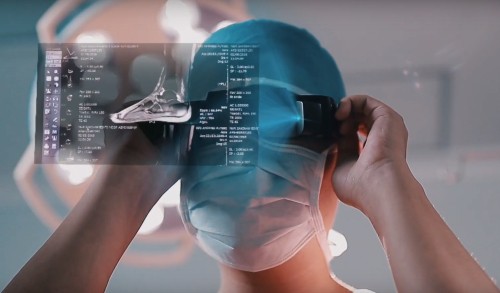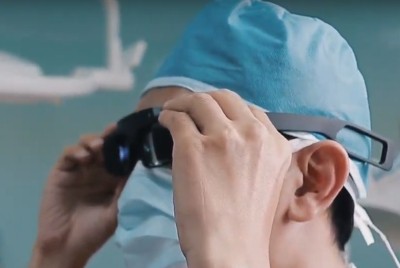If you have read my previous posts, you have already seen how the ever-so-nifty smart glasses can be beneficial in day-to-day life. However, in addition to this, they also have many specialized uses in various other different fields. One of these fields is medicine and surgery.
Augmented reality (AR) has the potential to help transform the face of medicine, and in many cases is already doing so. It can be useful in many different aspects of surgery. Starting with helping to “see inside” the patient and ending with helping doctors remotely assist their colleagues with important procedures.
I did some research and will try to give an overview of the main uses of AR in surgery. We are also going to look at some of the surgical smart glasses currently on the market. And don`t worry, I will be doing all of this in human language and not using complicated medical jargon.
How augmented reality can be implemented in the OR
AR has actually been used in surgery longer than you might think. Although smart glasses are a fairly recent invention, augmented reality has been used in surgery for a while. The first recorded use in surgical setting was in 1986 when a surgical microscope was used to superimpose a computed tomography (CT)-derived tumor onto the surgical field.
The use of these kinds of Heads-Up-Displays (HUDs), which present data without requiring users to look away from their usual viewpoints, is still very prevalent today. It’s an important use of smart glasses in surgery, as an AR headset (such as the Microsoft HoloLens) would enable the surgeon to see images and data directly overlaid over their field of view.
Smart glasses can display patient data such as an echo-cardiogram with vital signs and data directly above the surgical field. This can make procedures safer, as the surgeon does not need to look away from the patient to separate displays. All the data is gathered in one place – displayed inside the smart glasses. This in turn also makes procedures less time consuming.
AR’s ability to display imaging data would be especially useful in situations outside of the OR. In the OR, a patient has an entire team of dedicated doctors and nurses. Since there is a whole team, including anesthesiologists and surgical nurses, the surgeons can be completely immersed in their task.
However, small and emergent bedside procedures find patients most at risk and in this, AR could be greatly beneficial. In these emergent situations, there are usually only one doctor and one nurse, who also have other responsibilities while working with the patient.
In addition to this, the rooms themselves are also not specifically designed for procedures and in many cases may involve cumbersome methods of imaging.
This is where AR with a single display integrating all important patient data is incredibly useful – it allows doctors to keep their entire attention on the patient. The result is improved quality and safety and also reduced costs of these emergent bedside procedures.

In addition to reducing costs by safer procedures, AR also has the potential of helping to eliminate excessive number of screens. The current economic model is sadly focused on selling whole systems with incompatible imaging devices. Meaning, every electronic medical record has its own display, and data from the devices isn’t merged.
As AR can provide a shared display, it would mean eventually reducing the need for a monitor for separate aspects of a patient’s data.
Even though there is a lot of room for improvement, both in terms of technology and doctors getting on board, many of these benefits of AR are already being implemented in the real OR thanks to innovative smart glass technologies. Let’s take a look at what is already available on the market.
Microsoft’s HoloLens enables surgeons to see inside the patient
One of these great technologies comes from Microsoft in the form of the HoloLens. Truth be told, they are not designed specifically for use in surgery and can be used in many different fields. The technology for surgery, however, has been developed in collaboration with Philips’ Azurion image-guided therapy platform, which is used with the Microsoft’s Hololens version 2.
Like the name implies, Hololens essentially creates ‘holograms’ for the surgeon wearing the headset. ‘Holograms’ meaning that the computer-generated objects (such as through CT scans, X-rays, ultrasounds) are made visible through the glasses.
The technology has been used, for example, to overlay images of CT scans, which include the position of bones and key blood vessels, onto the patient’s leg. This enables the surgeon to ‘see through’ the limb during surgery.
The HoloLens is very useful in minimally invasive therapies, which only require a small incision and in which dedicated instruments such as catheters are guided to the treatment area. Treatment areas may include the heart, blood vessels, brain, liver and other major organs. Since doctors cannot directly see or touch the treatment area, they rely on imaging technologies such as X-rays and ultrasound to treat the patient.
In this case the use of 3D holographic images via AR is very beneficial. What else is beneficial is that the Philips’ Azurion image-guided therapy platform can be controlled with voice recognition, eye tracking and advanced gestures. That way the surgeon can keep their entire focus on the patient.
Although the holographic solution sounds rather futuristic, it has already found wide use. As of March 2019, over half a million patients in more than 80 countries have been treated using the Azurion platform.
AR could help reduce exposure to radiation from X-rays
Another example of AR designed specifically for use in the surgical field comes from Foresee-X by Taiwan Main Orthopaedic Biotechnology. Similar to the HoloLens, it also allows surgeons to focus on the operational field instead of computer screens and monitors.

Foresee-X also claims to help reduce the exposure to radiation from X-rays. Rather than having to take the traditional 150 X-ray photos during surgery, the new technology enables to lower the number to 20 X-rays.
The product enables the surgeon to “look into” the patient during surgery. X-ray images or tissue images of the patient can be viewed in real-time and in full HD resolution. This is possible due to the four infra-red sensors in the glasses, which determine the relative position of the projected image to the patient.
Taiwan Main Orthopaedic Biotechnology has also introduced the second generation smart glasses for surgery, which are called Caduceus and according to the website are ‘Comming soon’. I do hope their technologies are better than their spelling (and from the sound of it, they seem to be).
Smart glasses to help doctors assist their colleagues remotely
Another important feature smart glasses offer is telemedicine, which allows health care professionals to evaluate, diagnose and treat patients at a distance using telecommunications technology.
Smart glasses are perfect for telemedicine, as they have the capacity to e-mail, text message, phone and video call, enabling doctors to effectively communicate with each other in order to address different factors of a patient’s health.

According to a research written in 2015 on the clinical and surgical applications of smart glasses, emergency settings especially would benefit from the increased interaction between physicians. Doctors could be more efficiently consulted and involved in treating patients and saving lives.
Telemedicine would also be very helpful in emergent trauma situations even before the patient arrives at the hospital. It would enable relevant patient information to be relayed wirelessly ahead of time and help with the physician’s ability to diagnose and treat. In the United States, there is a large deficiency of trauma surgeons, and furthermore, 30% of U.S. residents do not live within 45 minutes of a trauma center.
Telemedicine has already been around for a while. One example is the iPod Tele-trauma program used in Maine Medical Centre. However, by substituting handheld devices such as an iPod, with smart glasses, it would make telemedicine more convenient. Doctors would be able to interact hands-free and perform certain features of the clinical examination.
Video Conference
Videoconferencing is another feature of smart glasses, which can be useful in medical situations. Research paper mentions a case where Google Glass was used for telemedicine in a cardiology fellowship program. Early stage trainees could use the the glasses when being faced with challenging clinical situations.
Video conferencing via smart glasses is especially beneficial because unlike using phone calls for consultation, video conferencing enables the physician to see what the trainee sees and therefore give better assistance.
Telemedicine can also extend into the operating room for assistance with challenging cases or for colleagues to provide advice and feedback about surgical technique.
Like mentioned before, the good ol’ Google Glass has already been used for telemedicine. However, smart glasses solutions specifically for telemedicine have also been developed.
For example, in 2018, this Dutch firm called 1Minuut Innovation launched a program aimed specifically for telemedicine and “hands-free clinician-to-clinician video”. The platform uses Vuzix M300 Smart Glasses.
How smart glasses can help war zone medicine
Another incredibly important field where AR can be of help is in war zone medicine. Researchers at Purdue University use the possibilities of augmented reality to connect health care professionals in war zones, natural disasters and in rural areas to more experienced surgeons and doctors around the world.
According to the project’s team leader Juan Wachs, this technology can help minimize the number of casualties while maximizing treatment at the point of injury.
The Purdue system features a transparent headset screen display, which allows the mentee to see the patient in front of them, as well as real-time feedback from their mentor. The mentor is at a remote location, seeing the AR feed through a video monitor and providing instant feedback to the surgeon in location.
What I thought was especially cool about this system was that the mentor could make virtual notes and marks on the screen, for example where to make the incision etc, which the mentee would be able to see and follow.
A testament to just how useful the Purdue AR system for war field medicine is, is the fact that the U.S. Department of Defense has supported their research. The technology has gone through a clinical evaluation and is soon about to go through another.
Conclusion
To conclude, it is pretty safe to say that AR has a place in the OR. Smart glasses are already being implemented with many different functions in mind, and hopefully as technology advances even further, more hospitals and doctors will jump on the augmented reality train. All for the good cause of safer, more accurate and cost effective patient treatment.
